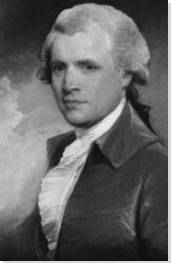Summary of John Singleton Copley
Having almost single-handedly created a vision of what Federal Period art would be, Copley rightfully takes his seat in the pantheon of great American artists. The supreme colonial artist, and by common consent the greatest American painter of the eighteenth century, his portraits have become symbols for the US's merchant class and helped mark America's "coming of age" as an independent nation. Having moved to England, he matched his success in America by adding historical painting to his repertoire. Known as a figure with exquisite artistic and social skills, he became a key figure in the British art scene having been elected into the Royal Academy and receiving royal patronage until the end of his life.
Accomplishments
- Copley's direct approach to characterization presented a challenge to the more romantic contemporary English society portraits from which he took his lead. His eye for direct observation gave rise to a series of natural portraits that conveyed the nobility and heroism of pioneers of the early American way of life.
- In producing portraits of Paul Revere, and American founding fathers like Samuel Adams and John Hancock, Copley, albeit inadvertently, documented the building of the American nation. His sophisticated early portraits reveal the country's coming of age as a self-governing entity.
- The excellence of Copley's portraits could be attributed in part to an academic foundation. A book of Copley's studies of the human anatomy (now housed at the British Museum) shows that he was making precise anatomical drawings before the age of twenty. His swift ascent and sustained eminence in England meanwhile was a result of his innate ability to handle paint and to produce images that overshadowed anything seen before by an American artist.
- Copley was one of the pioneers of the private exhibition, promoting his art and marketing prints of his own work to mass audiences in England. As a result, Copley's work saturated the market to a degree that was then unprecedented in the history of commercial art.
The Life of John Singleton Copley
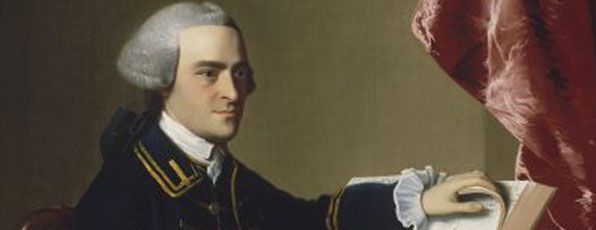
American Patriot John Hancock is best known for his beautiful signature (on the Declaration of Indepednce), eventually his name is used to refer to one's signature. Copley made a portrait of Hancock, and others at the forefront of the American dream, and his pictures of the founding fathers foretold stories of economic strength and freedom of the new nation.
Important Art by John Singleton Copley
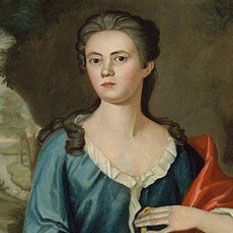
Mrs. Joseph Mann (Bethia Torrey)
Though Copley was only 15 years of age when he produced this, one of his earliest known portraits, he had already had extensive access to early eighteenth century prints, and borrowed compositional features, such as posture and clothing, to inform his own portraits. Rather than plagiarism, however, it was the accepted practice for aspiring artists to self-learn by copying the work of earlier masters. Here, for instance, Mrs. Joseph Mann, the 22-year-old wife of a tavern keeper in Wrentham, Massachusetts, handles a string of pearls, and her attire, a white-trim, scoop-neck dress, mirrors directly a mezzotint of William Wissing's portrait of Princess Anne.
Despite the requirement to copy, Copley was already applying Bostonian traits that would appeal directly to tastes of his patrons. Here, for instance, Mrs. Mann is posed against an American landscape setting. Her portrait might have even been seen as provocative to conservative tastes since the removal of her necklace invites the suggestion that she is about to undress. Copley offsets this potential scenario however by raising her bodice to cover her cleavage. He also gives Mrs. Mann a cold detached stare which went against the more alluring gaze in the Princess Anne portrait.
Copley's portrait had manifold technical shortcomings - brushstrokes are still very heavy, there is little-to-no sign of textual subtly between sitter and her surroundings, and Mrs. Mann's anatomy (the little finger on her left hand for instance and her missing earlobe) lacks coherence - yet despite these flaws there is a great deal to admire in the fledgling work of an artist of such tender years. Notably, Mrs. Mann possess a very strong psychological presence and this, coupled with his bold use of color, had already started to distinguish Copley from his mentors.
Oil on Canvas - Museum of Fine Arts - Boston
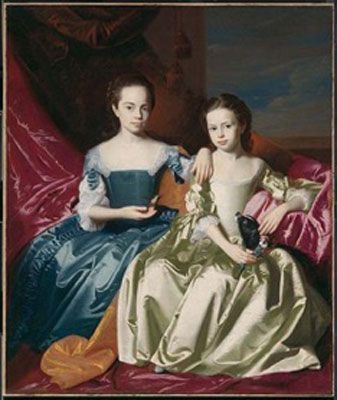
Mary and Elizabeth Royall
An early commissioned portrait, Mary and Elizabeth Royall shows the two daughters of Isaac Royall, one of New England's most prevalent merchants. In the painting, teenaged Mary (on the left) and Elizabeth, her younger sister, gaze outwards. They are both dressed in rich, highly detailed jewel-toned dresses that indicate their wealth. As is common in his portraits, Copley used props to add meaning: Mary holds a pet hummingbird, which may suggest her father's trades in the West Indies, while the King Charles Spaniel (thought to have originated in East Asia) in Elizabeth's lap was a breed made famous in the seventeenth century through their association with King Charles II. The velvet drapes that surround them reinforces the sense of regal opulence in the work.
Art historian Paul Staiti remarked that the patron "undoubtedly hoped [the piece] would read as a pageant of his family's wealth". However, it is not only wealth that makes this portrait seem like the daughters' "coming out"; Copley also carefully rendered the sitters' personalities and their bond. Mary's left hand, which rests on her sister's shoulder, lends a casualness to the otherwise highly formal scene. This ability to innovate with the traditional genre of portraiture by capturing personality through small details in posture and expression set the artist aside, and made him Boston's most popular portraitist even at the age of just 22.
According to Erica E. Hirshler of the Boston Museum of Fine Arts, the "obedient pets and the girls' modest demeanor were [...] meant to indicate the girls' character, showing them to be polite, disciplined, well-mannered young women - good daughters and good future wives". As she says, "this projection did indeed come to pass" when Elizabeth married William Pepperell, the son of the merchant Deacon Nathanial Sparhawk, in 1767, and Mary married George Erving, the American diplomat (and later US consul in London) in 1775. Erving left for England in 1778 and was reacquainted there with Copley who painted a family portrait that included a posthumous likeness to Elizabeth who had died from dysentery in 1775.
Oil on canvas - Museum of Fine Arts, Boston
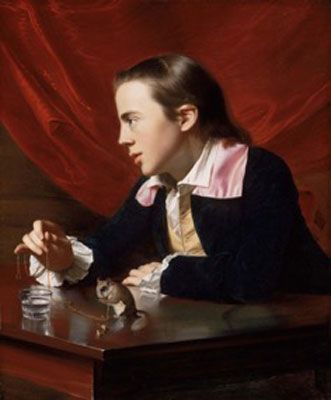
A Boy with a Squirrel
A Boy with a Squirrel, considered by many to be Copley's greatest masterpiece, was the artist’s first submission to the Society of Artists in London (in 1766). The subject is Copley's younger stepbrother, Henry Pelham, and was the first of his portraits to be exhibited overseas.
The varied elements of the composition offered the artist the chance to promote his technical abilities amongst his European colleagues; the image's textural complexity; its light and shadow, is in abundant evidence through the contrasts between the clothing materials, the water, the fur of the squirrel, the gold of the boy's chain, and the velvet backdrop. Yet perhaps the most striking formal feature of the painting is in the rendering of the highly polished mahogany table. Copley demonstrates his deft ability to capture reflections, shown here in the detail of the nut, the glass of water, the squirrel's white abdomen and even the sitter's white cuffs.
Copley also dared to show Pelham in profile which was exceedingly rare for portraiture of this period. Complementing its textural quality, then, Copley brings a psychological ambiguity to the portrait. Looking beyond the picture frame, Pelham could be observing an out of frame incident or, as seems more likely, he is caught in a state of adolescent reverie. The painting had been delivered to London by Copley's friend R. G. Bruce who returned to New England with the glowing endorsement of Sir Joshua Reynolds who wrote "in any collection of painting [A Boy with a Squirrel] will pass for an excellent picture, but considering the disadvantages ... you had labored under, that it was a very wonderful Performance". Reynolds was referring to Copley's limited circle of peers in Boston and the Englishman's endorsement finally persuaded him to further his career by relocating to London.
Oil on canvas - Museum of Fine Arts, Boston
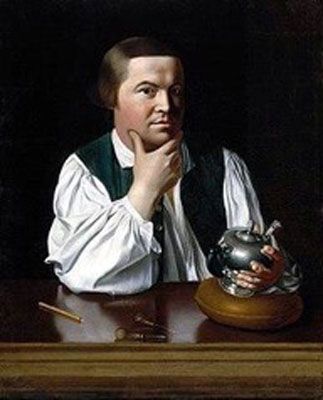
Paul Revere
Copley's portrait of Paul Revere, the silversmith, and later folk-hero of the American Revolution, saw the artist turn away from his usual merchant subjects. The image, however, predates Revere's historic night-time ride to Lexington on the eve of the revolution that alerted the colonial milia of the approach of British troops (and thus allowing Revolutionary leaders John Handcock and Samuel Adams to escape capture). Here though he was meant to be viewed very much as an "ordinary" artisan. Revere, like Henry Pelham in Boy with a Squirrel, is shown sitting at a reflective polished wooden table. His right hand placed on his chin, Revere adopts a considered pose as he engages the gaze of the viewer. In his left hand is an undecorated silver teapot, while placed on the table are his engraver's burins.
On the one hand, Copley's painting presents an idealized version of Revere's working conditions: the table is too clean and polished to resemble a working bench and the silversmith's clothes and hands are washed clean. On the other, it is, by the standards of the day, a rather informal portrait. At a time when it was the norm for sitters to present in their "Sunday best", Revere is shown in his working attire, a choice that acts to displace his middle-class status. His shirt is fashioned from plain white cotton, he is missing any formal neckwear (such as a cravat) and his waistcoat is unbuttoned. Nor does he wear a jacket or wig, the latter being a staple status symbol for a person of Revere's social standing.
Though Copley prided himself on his political neutrality, his portrait of Revere, an engraver of political cartoons since 1765, carried political symbolism. A silversmith would craft many objects, such as buckles, cutlery, tankards and sugar tongs, yet the fact that he is pictured with a teapot seems like an overtly political gesture. A year before the painting was produced, the British government had passed to so-called Townsend Act which imposed taxes on tea (in addition to some other imported goods). Indeed, tea had by now become a divisive commodity and led, ultimately, to the Boston Tea Party of 1773 in which radicals raided vessels in Boston Harbor and threw the cargo of tea overboard.
Oil on canvas - Museum of Fine Arts, Boston
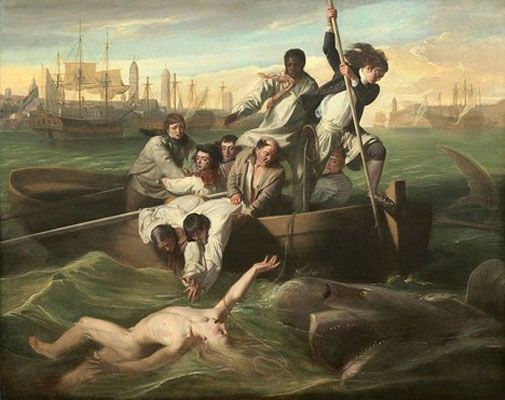
Brook Watson and the Shark
In Brook Watson and the Shark, Copley applied his skills in portraiture to a narrative featuring multiple figures. The painting garnered widespread praise when exhibited in 1778 at the Royal Academy. The work depicts a real event from about 30 years prior where Brook Watson, a 14-year-old crew member on a trading ship in the West Indies, decided to abandon his heavy clothes and go for a swim. Soon after entering the water he was attacked by a shark. Here, Copley has pictured the dramatic moment where Watson is about to be rescued, just in time to save him from being attacked by the shark for a third time (close inspection of the lower-left corner shows that his foot is already missing). One reviewer at the Royal Academy felt moved to recommend the painting for the "softness of coloring" and the "frightened appearance of the man assaulting the shark".
Aside from being a prime example of Copley's ability to represent a dramatic story, weaving nuances into each figure through their expressions, the work was also a work of experimentation for the artist. Art historian Bryan Zygmont has compared the many figures, most notably the harpooners, to works by Raphael that Copley would have studied on a tour of Italy. Others have drawn connections to 18th-century French painting. Whatever Copley's formal influences, the work was unlike anything he had produced till that point. It also signals one of Copley's ambitions: to be accepted as a history painter which was then regarded as the noblest genre.
With the help of this composition, Copley, who was made an associate member of the Royal Academy of Arts in 1776, succeeded in his ambition of gaining full membership in 1779. In addition, this work was widely circulated in prints, and even prefigured the theme favored by Romantic artists whereby man is pitched against the forces of nature. As Historian James Thomas Flexner observed, Theodore Géricault's The Raft of the Medusa "is so close [...] in subject matter and conception that some critics believe that the French artist must have been influenced by an engraving after the American's picture".
Oil on canvas - The National Gallery of Art, Washington DC
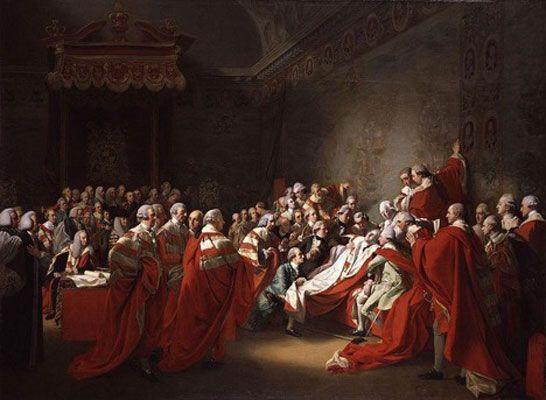
The Death of the Earl of Chatham
The Death of the Earl of Chatham is one of Copley's most famous mature works. It exemplifies his skill at blending the best qualities of portraiture with history painting. Here, the Earl of Chatham is shown moments after he had delivered a speech to the House of Lords through which he sympathized with the plight of Americans despite arguing against independence. To create this 7.5 by 10 foot-canvas, Copley painted the likenesses of each present member of Parliament leading to some 55 individual portraits within the overall composition. On the surrounding walls, the artist included tapestries depicting Britain's defeat of the Spanish Armada.
The artist's dexterity at constructing compositions shines through in this work. Rather than placing the Earl of Chatham in the center, he has painted him slightly to the right. This allowed Copley to heighten the sense of drama through the use of light, guiding the viewer's eye to the collapsed figure. Doing so was an astute decision: with so many figures dressed alike in a small space, he needed to create open space in the composition to emphasize the event.
Both Copley and Benjamin West started compositions of this event, but West left his unfinished so as to not interfere with the possibility of his friend's success. It was a generous gesture based on the fact that Copley was struggling financially at the time. Indeed, the painting marked a pivotal shift in the artist's commercial outlook. Recognizing the special merits of the work, he rented a separate room to exhibit the painting on its own at the same time as the annual Royal Academy Exhibition, which featured works by Gainsborough and Reynolds, and charged for admission. He also converted the composition into prints for wider circulation. Copley's risk paid off. His single work exhibition brought in over 20,000 paying visitors, while the Royal Academy's exhibition lost about a third of its viewers. The merchants who supported Chatham also began to commission Copley for portraits, bringing him much needed commercial fortune.
Oil on canvas - National Portrait Gallery, London
Biography of John Singleton Copley
Childhood and Education
John Singleton Copley was born in 1738 to Irish immigrant parents, most likely in Boston, Massachusetts. A tobacconist by trade, his father, Richard Copley, moved to the West Indies around the time of his son's birth in an attempt to improve his failing health where he passed away nonetheless, leaving his son's mother, Mary Singleton, to manage the family business and to raise her son as a single parent.
There is little definitive information about Copley's childhood, which makes his early artistic development difficult to trace. His stepfather, Peter Pelham, an engraver, is thought by scholars such as William H. Whitmore to have introduced Copley to the fine arts. It is highly likely that Pelham instructed Copley in both painting and engraving, but this early exposure to art notwithstanding, Copley was largely self-taught.
Copley's artistic career began in earnest in 1751 at the age of thirteen when, following the death of his stepfather, he set up shop as a painter and engraver to supplement the income from his mother's tobacco shop. There, he painted portraits of Bostonians and British officials. However, these early works, while impressive for a boy of his age, betrayed Copley's inexperience through their occasional crude or awkwardly represented detail.
Mature Period
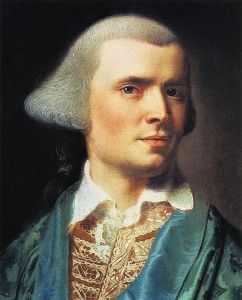
Copley's mature style began to develop after meeting the British artist Joseph Blackburn who had arrived in Boston in 1755. Copley, still in his late teenage years, borrowed elements of popular British portrait painting from Blackburn, including intense jewel tones, elaborate fabrics, and even gestures of Blackburn's sitters. However, according to art historian Janet L. Comey, Copley began to surpass Blackburn by representing his sitters as "more alert and active" and through a "superior ability to replicate sumptuous materials" and to capture "genteel poses". The fine detail in Copley's painting no doubt benefitted from the fact that he had begun to produce books of anatomical drawings based on European examples.
As he matured, Copley continued to seek out examples of art from which he could learn to improve on his own technique. Disappointed by materialistic treatment of the arts in the US, he once lamented the poor public status of American portrait artists: "The people generally regard it [portraiture] no more than any other useful trade, as they sometimes term it, like that of a carpenter tailor, or shrew-maker [sic], not as one of the most noble arts in the world. Which is not a little mortifying to me". Nor did Copley, who also explored making miniatures during this time (though he quickly gave these up as they brought in too little money), receive significant advice or encouragement from his more highly esteemed British counterparts. They ignored the young American's written requests for artistic direction: "I shall not be benefited by them in this country, neither in point of fortune nor fame" he lamented.
This feeling of isolation, coupled with Copley's introversion - it is said he never had a true friend in America, only familial relationships and formal relationships with his sitters - spurred him to try to engage with the art scene in Britain. Recognition arrived for the artist in 1766, when he sent one of his paintings to be displayed in the Society of Artists exhibition. The first President of the Royal Academy, Joshua Reynolds, commented positively about his work while noting Copley's lack of direct access to examples of fine art. Both Reynolds and Benjamin West, a renowned American artist already residing in Britain, noted that there was a certain hardness to Copley's work and duly encouraged him to spend time in Europe to finesse his talent.
Despite this reassurance, and not wanting to make the journey across the Atlantic without the certainty that he would thrive as a portrait painter (as he did in the colonies), Copley decided to stay in Boston. His standing was such that he was able to marry Susanna Farnham Clarke, a member of a prominent Tory family, in 1769. Copley's marriage into a family of Boston's elite granted him access to important individuals who would come to be the founding fathers of the United States. John Hancock, influential patriot of the American Revolution, for instance, was one of his next-door neighbors in his home in (what is now) Beacon Hill.
In the subsequent years, Copley would have his first child, a daughter named Elizabeth, followed by his son John Copley I, and two other children who did not survive into adulthood. This period remains the high point in his artistic career as he painted more quickly and charged more than his competitors for his portraits. He also witnessed some of the most important moments in American history, including the Boston Massacre. Copley longed to remain politically neutral, though his portrait commissions connected him mostly to the Patriots - those republicans who fought for independence from British colonial rule - while his wife's family remained committed Tories - those who supported the conservative and Royalist rule of the Loyalists. As political tensions continued to mount, an incident occurred where Patriots threatened Copley with violence for having Loyalist affiliations: "What if Mr. [Colonel George] Watson had stayed (as I pressed him to) to spend the night. I must either have given up a friend to the insult of a Mob or had my house pulled down and perhaps my family murdered" Copley wrote.
Given that Copley could only reach a limited audience in his colonial town, West, with whom he had entered into regular cross-Atlantic correspondence, had written to Copley suggesting he finally come to England to ply his trade. Though still reluctant to leave his comfortable home life behind, political tensions shifted his attentions back towards Europe and following a six-month journey to New York, where he earned 700 British Pounds painting portraits, and Philadelphia, where he studied replicas of European masterworks, Copley, at West's continued insistence, relocated to London in 1773.
Late Period
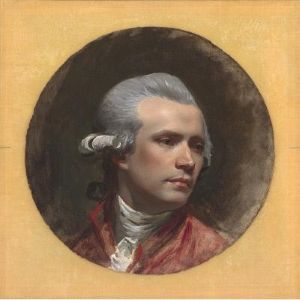
Copley left for Europe at the begining of 1774, leaving behind his elderly mother, his half-brother Henry, his wife, and his four children. Once arrived in London, he was greeted with warmth and kindness, and finally met with his overseas correspondents. He made his most important early connection with British artist George Carter, with whom he traveled to France and Italy where they analyzed first-hand the works of the great European masters. Their friendship quickly soured, however. Carter's diaries provide almost comical descriptions of Copley as a most fussy traveller. Carter recalls telling his companion, "I have taken as much pains as to the mode of conveying you as if you had been my wife, and I cannot help telling you that she, though a delicate little woman, accommodated her feelings to her situation with more temper than you have done". Regardless of these interpersonal complications, Copley finally saw works by Old Masters, though he found himself surprisingly disappointed. Still, looking through hundreds of works in Italy, he nevertheless found the framework to experiment in new "European" ways.
As the Revolutionary War in America inched nearer, Copley urged his wife and their children to leave Boston and meet him in London, which they did in 1775. Although this period is not considered Copley's most productive, he did manage to begin his first historical painting and to receive an invitation to become a member of the prestigious Royal Academy of Arts. His historical scenes showcased a commitment to psychological portraiture - his trademark - combined with an interest in historical scenes.
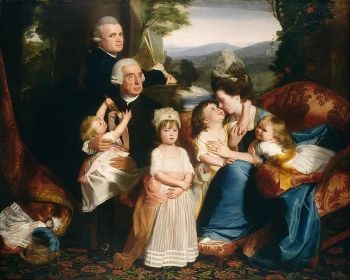
Despite the happiness of being reunited as a family, the Copleys struggled in London. The difficult political situation meant that his assets were stuck in Boston. Although Benjamin West tried his best to secure Copley commissions, Copley struggled to earn enough to adequately support his family. The necessity to earn a living wage convinced him that continuing with his overly-honest American style would not do and he tried to paint in the style that was fashionable. He produced works that, while not especially popular with British academicians and elites, are now considered seminal works in the artist's oeuvre. At this time he also set important precedents when it came to putting on private exhibitions (outside of the Royal Academy) and marketing reproductions of his own work. As Carrie Rebora Barratt of the Metropolitan Museum of Art put it, "the possession of works of art - especially English-style pictures - by an artist as accomplished as Copley was of immeasurable social value. Typically displayed in the halls, parlors, and dining rooms of homes decorated with Chippendale-style furniture, Rococo tea sets, and other fine things, Copley's portraits became centerpieces in the stagecraft of elite, eighteenth-century life".
The tide of personal fortune changed for Copley in 1778 when the Earl of Chatham had a stroke while addressing the House of Commons. The painting he created of the event brought him significant commercial success, temporarily alleviating his financial burdens. This, however, did not keep the artist from feeling homesick. Nor could he escape his financial struggles since the art market in Britain declined in the shadow of the French Revolution, the war with France (declared by France in February 1793), followed by the Irish rebellion in 1798, and a continued decline into the Napoleonic era.
The last fifteen years of his life are described as unhappy. His student H.B. Morse recalls his tutor as being generally combative and irritable. Fortunately, his wife and children managed to physically and financially assist him, even after his first stroke at the age of 78 left him fully paralyzed on his left side. A second stroke, however, left him fully incapacitated. In his biography, his son writes that in moments of clarity, Copley would speak of his readiness to pass away, likely due to his inability to paint anymore. The artist died shortly after his second stroke on September 9, 1815.
The Legacy of John Singleton Copley
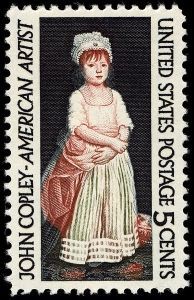
History has shown Copley to be the greatest, and most influential, American colonial painter; his fastidious attention to picture detail coming to define the realist tradition of American art. His legacy stretched throughout the nineteenth century influencing the fastidious luminist style of Fitz Henry Lane and the precise trompe l'oeil still lifes of William Harnett. Having relocated to London Copley continued with his sophisticated portraiture but his greatest gift to his adopted country was his contribution to the development of contemporary history painting to which he brought a dynamic blend of theater and detail. Public recognition of his significance to early American history is evidenced through spaces like Copley Square in Boston, and a 5-cent stamp produced by the USPS in 1965 bearing one of his paintings.
Influences and Connections

-
![Joshua Reynolds]() Joshua Reynolds
Joshua Reynolds -
![Raphael]() Raphael
Raphael - Peter Pelham
- Joseph Blackburn
-
![John Trumbull]() John Trumbull
John Trumbull -
![John Singer Sargent]() John Singer Sargent
John Singer Sargent -
![Théodore Géricault]() Théodore Géricault
Théodore Géricault -
![Kehinde Wiley]() Kehinde Wiley
Kehinde Wiley - William Harnett
-
![Benjamin West]() Benjamin West
Benjamin West - Henry Pelham
Useful Resources on John Singleton Copley
- John Singleton Copley in Americaby Carrie Rebora
- A Revolution in Color: The World of John Singleton CopleyOur Pickby Jane Kamensky
- John Singleton Copley in Englandby Emily Ballew Neff and William L. Pressly
- John Singleton Copley and Turkish Fashion in 18th-Century Americaby Carrie Rebora Barratt
- American Adversaries: West and Copley in a Transatlantic Worldby Emily Ballew Neff, Kaylin H. Weber, and 6 contributors
- John Singleton CopleyOur Pickby James Thomas Flexner
